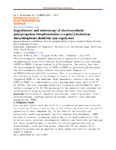| dc.contributor.author | Olowu, Rasaq A | |
| dc.contributor.author | Williams, Avril | |
| dc.contributor.author | Ndangili, Peter | |
| dc.contributor.author | Mailu, Stephen | |
| dc.contributor.author | Iwuoha, Emmanuel | |
| dc.date.accessioned | 2019-05-08T08:11:40Z | |
| dc.date.available | 2019-05-08T08:11:40Z | |
| dc.date.issued | 2011 | |
| dc.identifier.uri | http://ir.mksu.ac.ke/handle/123456780/4413 | |
| dc.description.abstract | The electrochemical impedance spectroscopy of generation 2 poly(propylenethiophenoimine)-co-poly(3,4 ethylene dioxythiophene) dendritic star copolymer(G2PPT-co-PEDOT) film was studied in LiClO4solution. The results show thatthe electrochemical deposition of G2PPT-co-PEDOT on gold electrode decreased the electrochemical charge transfer resistance when compared toAu|PEDOT|LiClO4and Au|LiClO4interfaces. This is attributed to an increase in the conjugation length of the polymer as result of the linking of the highly conjugated PEDOT to the dendrimer. Bode impedimetric analysis indicates thatG2PPT-co-PEDOT is a semiconductor with a maximum phase angle shift of 67.5°at 100 mHz. The star copolymer exhibited a 2-electron electro chemistry and a surface coverage of 97.3%. The morphology of the dendritic star copolymer was investigated by scanning electron microscopy and atomic force microscopy. | en_US |
| dc.language.iso | en_US | en_US |
| dc.publisher | International Journal of Electrochemical Science | en_US |
| dc.subject | Electrochemical impedance spectroscop | en_US |
| dc.subject | conducting polyme | en_US |
| dc.subject | atomicforce microscop | en_US |
| dc.subject | scanning electron microscop | en_US |
| dc.subject | dendritic star copolyme | en_US |
| dc.subject | nanomaterials | en_US |
| dc.subject | PEDOT | en_US |
| dc.title | Impedimetry and microscopy of electrosyntheticpoly(propylene thiophenoimine)-co-poly(3,4 ethylenedioxythiophene) dendritic star copolymer | en_US |
| dc.type | Article | en_US |

